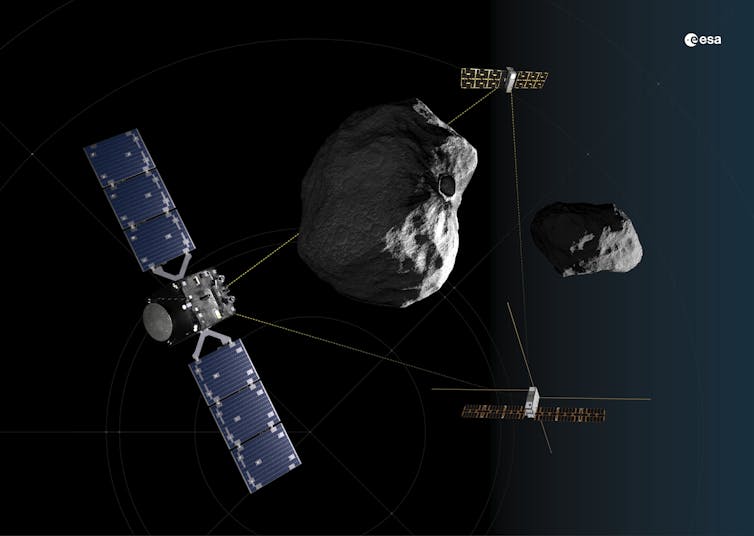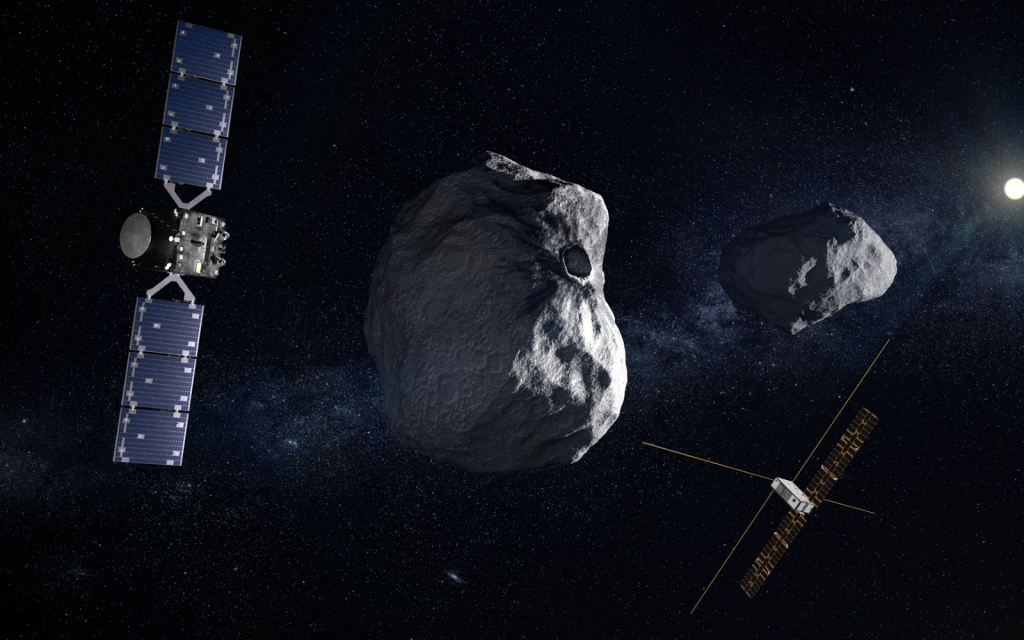The European Space Agency’s Hera mission will set off from Cape Canaveral on 7 October on a SpaceX Falcon 9 rocket. It will travel several hundred million kilometres to reach the double asteroid Didymos in autumn 2026.
This is the follow-up of the intentional impact of NASA’s DART probe onto the smaller body of this double asteroid, the moon called Dimorphos. This first-ever asteroid deflection test aims at modifying the trajectory of the target and understanding precisely what went on. And we already know quite a few things about the success of this deflection – thanks to a camera on-board DART, an Italian minisatellite (or CubeSat) deployed before impact, the combined power of ground-based telescopes, and the sharp eyes of Hubble and James Webb Space Telescope (JWST).
However, we lack a great deal of information to really understand what happened following the impact. This is essential for generalising the results and developing models that would enable us to deflect other asteroids that arrive toward the Earth or space installations (satellites, space stations…).
Understanding what Didymos and Dimorphos look like now is Hera’s mission.
What we already know about the deflection
This first-ever asteroid deflection test was a complete success. Firstly, because the DART probe successfully guided itself in the final hours before impact (autonomously) to collide with a small asteroid whose size was the main thing we knew about it.
Secondly, the collision did indeed deflect the trajectory of Dimorphos, as was shown by a campaign of observations by ground-based telescopes, spread out on most continents. Together, they measured the reduction in the orbital period of Dimorphos around Didymos (11.22 hours after impact compared with 11.55 hours before), also demonstrating the ability to organise on an international scale to measure the consequences of a deviation.
The images taken by DART before the impact also provided some knowledge of the surface properties of the Dimorphos target and its main body.
Finally, images taken by the Italian minisatellite LICIAcube, launched by DART before the impact to observe it from a distance, as well as images from the James Webb and Hubble space telescopes, which were pointing at the same object for the first time, showed that a tail of dust was emitted by the impact. And that this dust spread out over tens of thousands of kilometres afterwards, pushed by the Sun’s light exerting pressure on it (a phenomenon known as ‘solar radiation pressure’). Some of this dust could actually end up in the Earth’s atmosphere as shooting stars (with no risk of damage as they would burn up completely in the atmosphere).
Hera and her CubeSats, three ultra-sophisticated science detectives
But even all this information is not enough to measure the effectiveness of the asteroid redirection technique and to validate our modelling of such impacts – which must be able to reproduce this test at scale in order to extrapolate it to other scenarios.
Crucial questions remain unanswered. For example, to measure the effectiveness of the deflection, we need to know the mass of Dimorphos. To understand how the impact affected the double asteroid system, we need to know more about the physical properties of Dimorphos, and in particular its internal properties: Are there large voids inside Dimorphos, and what are the sizes of the boulders that make it up? Or is it a compact rock covered with surface rocks? Did DART’s impact produce a crater or did it change the shape of the small moon altogether, as some modelling predicts and some recent ground observations seem to indicate?

So, like a detective, Hera is now setting off to investigate and report back on exactly what happened and why. And Hera is the hero of this story, as it’s the first time a probe will move so close to a double asteroid.
It will also be the first time that a space mission has explored a small body using three satellites at the same time. Hera carries two “CubeSats”, each the size of a shoebox and equipped with its own propulsion systems and a variety of measurement instruments. They’ll be deployed in the vicinity of the asteroid to take measurements at closer range.
This configuration is intended to demonstrate the advantages of taking smaller modules on board, enabling us to take greater risks by deploying them for operations at very close range, while the main probe remains at a distance and ensures that the essential scientific objectives are met (the Hera probe itself carries two cameras for observation in the visible range, a hyperspectral imager providing data on mineralogical composition, a thermal infrared imager supplied by the Japanese Space Agency, the JAXA, to determine the thermal properties and roughness of the surface, and a laser altimeter).
Before receiving the first images of Dimorphos transformed by this first deflection test, we will have the opportunity to marvel at the probe’s flyby of Mars in mid-March 2025, during which the in-flight instruments will be calibrated by observing not only the planet, but also one of its two moons, Deimos… possibly offering new scientific data on its way.
Studying the consequences of the impact in detail so that they can be extrapolated to future collisions
This is also the first time that a mission has returned to a small body of which we already have images, but which we already know have nothing to do with what it has become. On the basis of current data – which is very partial – predictions are subject to considerable uncertainties, and several results are possible.
Read More: NASA wants to send humans to Mars in the 2030s − a crewed mission could unlock some of the red planet’s geologic mysteries
In fact, the DART data provides us with the initial conditions of the impact, but we lack the final result and the properties of the target that are involved in its response to the impact. Modelling based on the initial conditions provided by DART and the actual internal properties of the target that have yet to be measured, must reproduce the final result. The idea is to reduce the free parameters as much as possible to ensure that the models succeed in reproducing the impact, not because unknown parameters have been adjusted to achieve the desired result, but because they are valid and reliably capture the phenomenon on a scale that is inaccessible in terrestrial laboratories.
These validated models will later enable us to calibrate the impact energy required to deflect other asteroids with known properties.
- is an Astrophysicist, Research Director at CNRS, Scientific Manager of the Hera space mission (ESA), Côte d’Azur Observatory, Lagrange Laboratory, Côte d’Azur University
- This article first appeared in The Conversation

